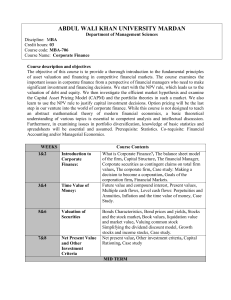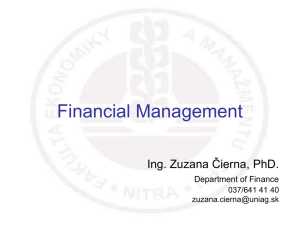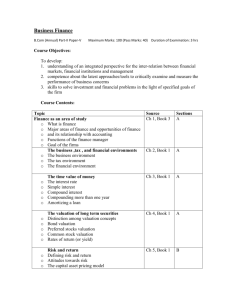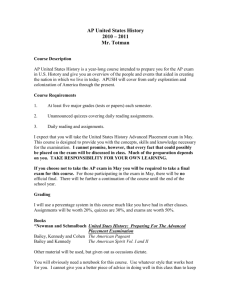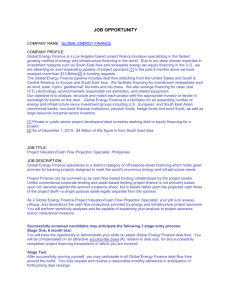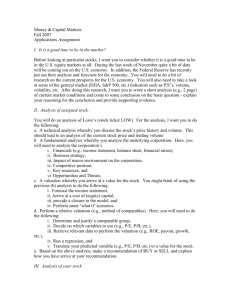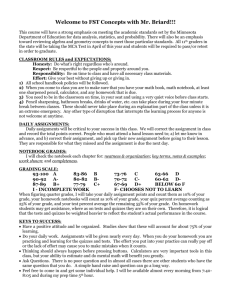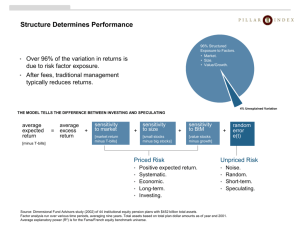Business Finance - iba - mba program
advertisement
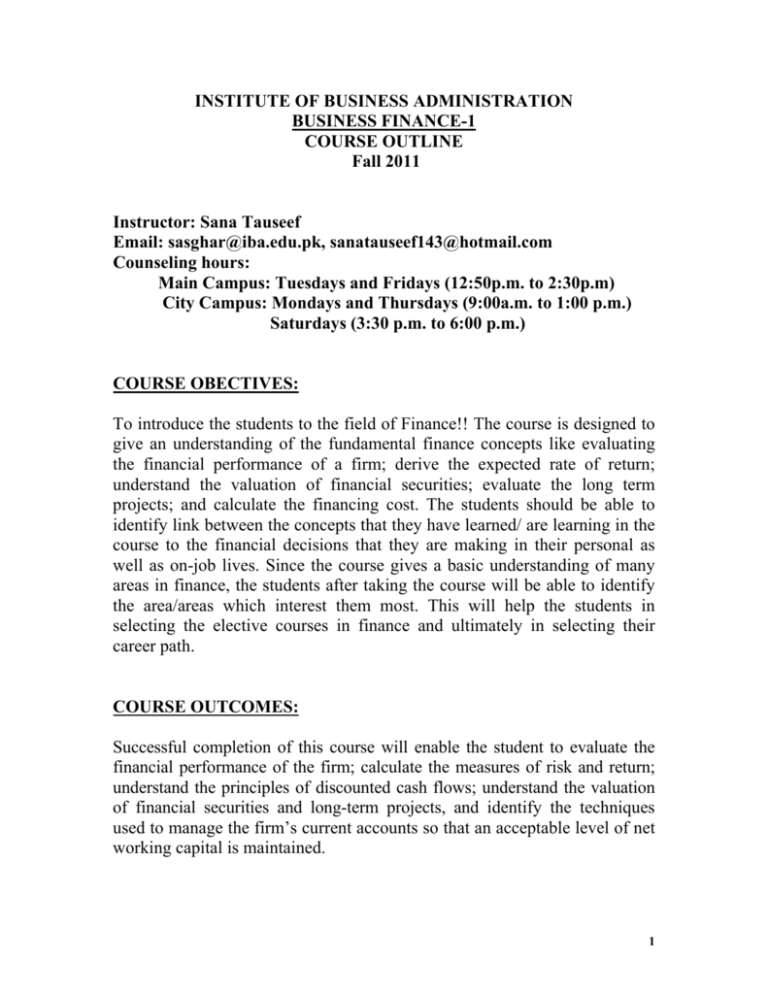
INSTITUTE OF BUSINESS ADMINISTRATION BUSINESS FINANCE-1 COURSE OUTLINE Fall 2011 Instructor: Sana Tauseef Email: sasghar@iba.edu.pk, sanatauseef143@hotmail.com Counseling hours: Main Campus: Tuesdays and Fridays (12:50p.m. to 2:30p.m) City Campus: Mondays and Thursdays (9:00a.m. to 1:00 p.m.) Saturdays (3:30 p.m. to 6:00 p.m.) COURSE OBECTIVES: To introduce the students to the field of Finance!! The course is designed to give an understanding of the fundamental finance concepts like evaluating the financial performance of a firm; derive the expected rate of return; understand the valuation of financial securities; evaluate the long term projects; and calculate the financing cost. The students should be able to identify link between the concepts that they have learned/ are learning in the course to the financial decisions that they are making in their personal as well as on-job lives. Since the course gives a basic understanding of many areas in finance, the students after taking the course will be able to identify the area/areas which interest them most. This will help the students in selecting the elective courses in finance and ultimately in selecting their career path. COURSE OUTCOMES: Successful completion of this course will enable the student to evaluate the financial performance of the firm; calculate the measures of risk and return; understand the principles of discounted cash flows; understand the valuation of financial securities and long-term projects, and identify the techniques used to manage the firm’s current accounts so that an acceptable level of net working capital is maintained. 1 COURSE CONTENTS: SESSION 1 2,3 4 5-7 8 9 DISCUSSION TOPICS Basics of Business finance; Importance of Financial Decisions Financial environment; Role of Financial Institutions and Intermediaries; Cost of money and its Determinants. Term Structure of Interest rates; Theories and practice Corporate taxes and their impact on investment and financing decisions Financial Health and Performance Assessment; CommonSize Statements; Liquidity, Solvency, Asset Management, Profitability and Market Value Ratios; Du pont Analysis; Sustainable Growth, PRAT Analysis; Discussion on short cases and Assignment 1 Financial planning; Projected Financial Statements Breakeven Analysis; Operating and Financial Leverage Analysis, measures and significance First Term 10-12 13,14 15 16,17 Risk and Return Analysis; Risk Diversification for portfolios; CAPM Model; Discussion of Assignment 2 Time value of money; Discounted Cash flows, Annuities and Perpetuities; Loan Amortization Features of Bonds (TFCs); Bond valuation; Calculation of Bond yields Stock valuation; No growth, constant and non-constant growth Stocks; Dividend and Capital Gains Yields Second Term 18,19 20,21 22,23 Capital Budgeting Projects, Projecting the Cash flows; Evaluation Techniques: Payback, NPV and IRR Relationships among the Working Capital Accounts; Working Capital Management Policies (Investing and Financing) Cash conversion cycle; Cash Budget; Managing Float (Collection and Disbursement) 2 24,25 26 27,28 Receivable Management; Credits standards; Credit terms and collection policy; Evaluating the Credit Policy Changes Inventory costs (Ordering, Carrying and Shortage); Inventory Management; EOQ Model Case: Clarkson Lumber. Discussions and Case-Based Assignment Revision of the semester work Case-based Assignment Discussion Agenda: • Assessment of Clarkson’s financial performance and health • Profit decomposition, impact of financial leverage, sustainable vs. actual and target growth rates, as well as business and financial risks. • Sources of financing the sales growth Assignment: Study Groups Set 1: Will represent Mr. Clarkson Set 2: Will represent Northrup National Bank • • • • Make the assumptions (financing, operating, working capital levels, etc) Prepare the 5-year business and financial plan Prepare the schedule of security pledges List the restrictive covenants Course Assignment # 1 (Individual): Analysis of Financial position and performance Selection of the company: 2nd session Criteria for Selection: • The Company must be listed on Karachi stock Exchange • At least five years of published financial statements must be available • The market share prices of the company are available from January 2010 till date Data Needed: Financial Statements (years ended 2006-2010) Source of Data: Primary and Secondary Required Calculations: • Common-size Statements for 5 years • Liquidity, Solvency, Asset Utilization, Profitability, and Market Value Ratios. Required Analysis: 3 • Comments on the financial health and performance of the company in relation to industry averages and competitors. • Comments on the change in ratios over the 5-year period, reasons for change? Due Date: 7th session Page limit: 6-10 pages (excluding the copy of financial statements) Course Assignment # 2 (Group, 2 students each): Analysis of Risk and Return of stocks and a two stock portfolio Data Needed: Week-end prices (January 2010 to August 2011) for two stocks listed on Karachi Stock Exchange and KSE-100 indices for the same days. If the last day of the week is a holiday, the closing price of the previous day should be taken. Source of Data: Secondary (www.kse.com.pk, www.brecorder.com) Required Calculations: – Weekly returns for each stock and the market. – Average weekly returns and the standard deviations. – Co-relation between the two stocks and the beta for each stock. – Risk and return for two-stock portfolio with different weights for two securities. Required Analysis: Comments on the relative riskiness of the two stocks, and on the risk of the portfolios. Linking the stocks’ market performance with the accounting performance. Due Date: 13th session Page limit: 4-6 pages Course Assignment # 3 (Individual): Article/ Topic Presentation The students will select a recently published article or a topic from any area of finance and make a 10 minutes presentation in class. The idea is to make the students familiar with the happenings in the financial world around them. Selection of the topic: Presentation Date: Will be assigned depending on the topic Examples: • Banking Sector Reforms in Pakistan (4th Session) • KSE-100 Index: Objective and Basic Calculation Methodology (11th Session) • Engro Rupiya Certificates (15th Session) • GDR Issuances by Pakistani Firms (16th Session) 4 TEXT BOOKS: Required: Financial Management: Theory and Practice. 13th Edition. By: Eugene F. Brigham & Michael C. Ehrhardt. Recommended: 1. Fundamentals of Financial Management, Ramesh K. S. Rao. 2. Fundamentals of Corporate Finance, Ross, Westerfield and Jordan. 3. Fundamentals of Corporate Finance, Brealey Myers Marcus. 4. CFA Level-1 Curriculum: Corporate Finance and Portfolio Theory. COURSE REQUIREMENTS: Students must bring text book in the class. The supplementary materials will be handed out in the class. It is anticipated that students prepare the topics in advance to be ready for the discussion and quizzes. Active class participation will be rewarded by adjusting the grade upwards when it is on the margin. Since subsequent topics build on previously learned material, it is imperative that students keep up with the material. In addition, students should ensure that lectures are understood properly. A student who misses a class is responsible for obtaining any handouts and information on course content, assignments, due dates, test dates, etc. Financial calculator is necessary in the class. The quizzes may be in advance or from the previous topic. There will be a perfect zero if you miss the quiz. You are expected to complete the assignments on the due date. No excuses will be entertained in late submission unless there is some extreme case. GRADING: Quizzes Home Assignments Class Assignments and Participation Term Exams Final Exam 10% 15% 10% 30% 35% 5
